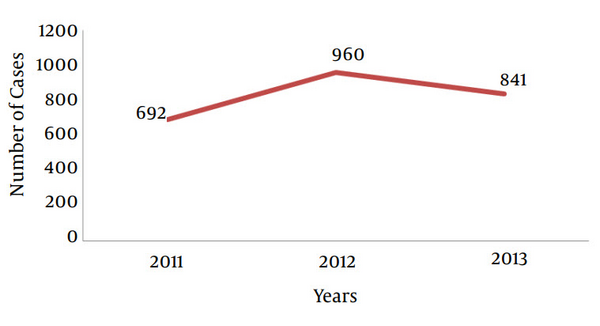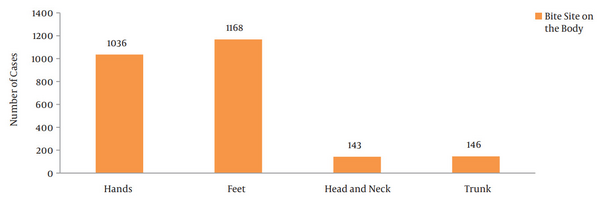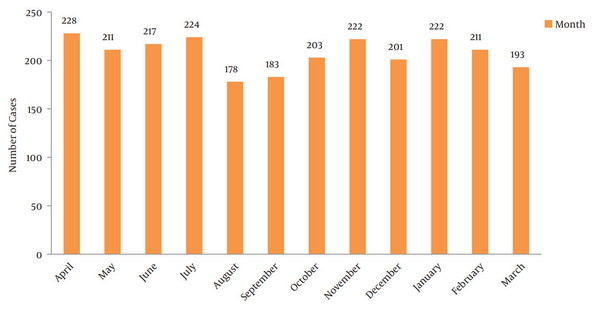1. Background
Today, a large amount of information is available concerning zoonotic diseases, which has resulted in substantial progress in their diagnosis and treatment. Nevertheless, a large number of animals and a more limited number of humans, continue to obtain such diseases (1). Transmitted diseases by animal bites have been regarded as a health issue throughout the world and Iran (2). In addition to their health significance to humans and livestock, such diseases impose a substantial economic burden on countries and are, therefore, of great significance (1). Every year, increased incidence of animal bites incurs enormous costs on the purchase of vaccines and serums to prevent and treat associated diseases (3).
Rabies is a fatal viral disease, transmissible between humans and animals. The cause of rabies is a neurotropic virus that is transmitted through (direct) contact with infected saliva from animal scratches or bites, mucous tissue, respiration, placenta, contaminated equipment, and organ transplants. The mortality rate of rabies is 100% following the emergence of clinical symptoms. It is an acute fatal viral syndrome, often accompanied by stimulatory disorder or paralysis syndrome, which is specific to domestic and wild carnivores. Rabies is transmitted to humans and other homoeothermic mammals, accidentally through infected bites. There are two epidemiological types of rabies: (a) urban rabies associated with dogs and, in a limited number of cases with cats, and (b) sylvatic rabies, whose natural reservoirs include wolves, foxes, weasels, raccoons, and bats (4, 5).
According to the World Health Organization (WHO) estimations, an annual 40 to 70 thousand people pass away due to catching rabies in endemic countries (6). An additional 10 million people receive post-exposure treatment following rabies-induced bites per year. According to estimations, three to six million cases of animal bites occur each year in the United States, with dog bites representing the majority of mammalian bites (7, 8).
Animal bites and diseases that are transmitted through it continue to remain a major economic-health issue in Iran, affecting almost all provinces to some degree. According to statistics reported by the Iranian Disease Management Center, the highest distribution of animal bites across the country belongs to the following provinces, respectively: Ardabil and Golestan with an incidence of over 450 cases per 100,000 people, Chaharmahal - Bakhtiari with 300 to 450 cases per 100,000 people, Bushehr, East Azerbaijan, Isfahan, Fars, Gilan, Kermanshah, Hamadan, Hormozgan, West Azerbaijan, Khorasan, Khuzestan, Kohgiluyeh - Boyer-Ahmad , Lorestan, Markazi, Mazandaran, Qazvin, Semnan and Zanjan with an average incidence of 100 to 300 cases per 100,000 people, and Tehran, Qom, Kurdistan, Ilam, Sistan - Baluchestan and Yazd with less than 100 cases per 100,000 people, exhibiting a low incidence (9).
Estimation of health and well-being indices of the society based on existing data is essential for the identification of health priorities and making relevant interventions, in a way that, the lack of epidemiological information is an inhibiting factor in disease prevention, control, and surveillance. In this regard, the identification of the epidemiology of animal bites and associated risk factors is of considerable significance. Numerous studies have recently been conducted on the epidemiology of rabies across Iran; however, due to extensive geographic scope, climatic variation and animal diversity in each region (some of these animals are natural reservoirs of rabies), along with demographic variations in terms of health level and knowledge of rabies prevention methods, it is necessary to conduct separate studies in each region of the country.
2. Objectives
Covering a large area, the city of Ahvaz (in Southwestern Iran) is home to various wildlife species. An understanding of the epidemiology and prevalence of animal bites as well as the age groups at risk can provide healthcare system planners with effective solutions to prevent this health issue. Therefore, this study was conducted to determine the epidemiologic condition of animal bites and its associated demographic factors in Eastern Ahvaz, during a three-year period (2011 to 2013).
3. Methods
In a descriptive cross-sectional study, all people bitten by animals between 2011 and 2013 were examined. Data was collected through interviews and review of statistics recorded in the Disease Prevention and Control Department of East Ahvaz Health Center. Informed consent was obtained from the respondents. They were made to understand that participation is voluntary and there was no consequence for non-participation. All obtained information was kept confidential. The college research review committee revised the paper, according to rules and regulations. Accordingly, the study was approved by the Ethics Committees of Ahvaz Jundishapur University of Medical Sciences. Eastern Ahvaz Health Services Center administrative authorities at the district level were informed about the study and their consent was obtained with a letter. The epidemiologic and demographic information included gender, age, occupation, season, place of occurrence (urban or rural), type of biting animal, site of wounds caused by bites, month and type of prophylaxis.
The East Ahvaz Health Center routinely collects data related to the incidence of animal bites (Disease Surveillance System). Incidents of animal bite are reported to the Center by regional units, such as hospitals and urban and rural health-medical centers via telephone for preventive measures to be taken, according to national instructions.
In the current study, two sources were used to report animal bites: (1) emergency departments of hospitals and (2) statistics reported to the center by other health-medical centers, such as urban and rural health-medical centers and health homes. However, the current study excluded cases not referring to health-medical centers, hospitals, etc. to receive prophylaxis.
4. Results
During the study, 2493 cases of animal bites undergoing medical intervention were recorded. The incidence of animal bites reported to the Center between 2011 and 2013 was 104, 142, and 124 per 100,000 people, respectively, indicating an upward-downward trend during this three-year period (Figure 1).
With respect to gender, animal bites were more common among males than females, with 1910 male cases (76.6%) and 583 female cases (23.4%). The majority and minority of victims belonged to the 10 to 20 (20.2%) and above 60 (2.7%) age groups in 2011, 20 to 30 (22.8%) and above 60 (3.6%) age groups in 2012, and 20 to 30 (23.7%) and above 60 (4.4%) age groups in 2013, respectively. In general, the majority and minority of victims belonged to the 20 to 30 (21.8%) and above 60 (6.3%) age groups, respectively (Table 1).
| Variables | Years | |||
|---|---|---|---|---|
| 2011 | 2012 | 2013 | Total | |
| Age group | ||||
| 0 - 4 | 62 (9.0) | 75 (7.8) | 43 (5.1) | 180 (7.2) |
| 5 - 10 | 113 (16.3) | 149 (15.5) | 71 (8.5) | 333 (13.4) |
| 11 - 20 | 140 (20.2) | 168 (17.5) | 128 (15.2) | 436 (17.5) |
| 21 - 30 | 125 (18.1) | 219 (22.8) | 199 (23.7) | 543 (21.8) |
| 31 - 40 | 112 (16.2) | 127 (13.2) | 171 (20.3) | 410 (16.4) |
| 41 - 50 | 63 (9.1) | 91 (9.5) | 112 (13.3) | 266 (10.7) |
| 51 - 60 | 58 (8.4) | 97 (10.1) | 80 (9.5) | 235 (9.4) |
| > 61 | 19 (2.7) | 34 (3.6) | 37 (4.4) | 90 (3.6) |
| Total | 692 (100) | 960 (100) | 841 (100) | 2493 (100) |
| Gender | ||||
| Male | 534 (77.2) | 768 (80.0) | 608 (72.3) | 1910 (76.6) |
| Female | 158 (22.8) | 192 (20.0) | 233 (27.7) | 583 (23.4) |
| Total | 692 (100) | 960 (100) | 841 (100) | 2493 (100) |
| Job group | ||||
| Rancher | 7 (1.0) | 4 (0.4) | 11 (1.3) | 22 (0.9) |
| Employee | 46 (6.7) | 83 (8.7) | 87 (10.3) | 216 (8.7) |
| Self-employed | 151 (21.8) | 216 (22.5) | 249 (29.6) | 616 (24.7) |
| Worker | 49 (7.1) | 42 (4.4) | 92 (10.9) | 183 (7.3) |
| Housewife | 66 (9.5) | 81 (8.4) | 124 (14.8) | 271 (10.9) |
| Student | 199 (28.8) | 232 (24.2) | 137 (16.3) | 568 (22.8) |
| Others | 174 (25.1) | 302 (31.4) | 141 (16.8) | 617 (24.7) |
| Total | 692 (100) | 960 (100) | 841 (100) | 2493 (100) |
| Residence area | ||||
| Urban | 433 (62.6) | 627 (65.3) | 560 (66.6) | 1620 (65.0) |
| Rural | 259 (37.4) | 333 (34.7) | 281 (33.4) | 873 (35.0) |
| Total | 692 (100) | 960 (100) | 841 (100) | 2493 (100) |
Distribution of Animal Bite Cases in East of Ahvaz County, Southwestern Iran (2011 - 2013) Based on Age , Gender, Job and Residencya
In terms of the frequency of occupation, 616 cases (24.7%) were self-employed, 568 cases (22.8%) were students, 271 cases (10.9%) were housewives, 216 cases (8.7%) were employees, 183 cases (7.3%) were workers, 22 cases (0.9%) were livestock farmers, and a total of 617 cases (24.7%) were either retired, unemployed, children or engaged in other occupations (Table 1).
In terms of the frequency of bites, dogs and cats accounted for the majority of injuries with 566 (81.8%) and 82 (11.8%) cases in 2011, 752 (78.3%) and 168 (17.5%) cases in 2012, and 636 (75.6%) and 182 (21.7%) cases in 2013, respectively. In total, dogs accounted for the majority of animal bites with 1954 (78.4%) cases followed by cats with 432 (17.3%) cases, and other animals (fox, wild boar, etc.) with 107 (4.3%) cases (Tables 2 and 3).
| Variables | Years | |||
|---|---|---|---|---|
| 2011 | 2012 | 2013 | Total | |
| Type of biting animal | ||||
| Dog | 566 (81.8) | 752 (78.3) | 636 (75.6) | 1954 (78.4) |
| Cat | 82 (11.8) | 168 (17.5) | 182 (21.7) | 432 (17.3) |
| Others | 44 (6.4) | 40 (4.2) | 23 (2.7) | 107 (4.3) |
| Total | 692 (100) | 960 (100) | 841 (100) | 2493 (100) |
| Bite site | ||||
| Hands | 283 (40.9) | 381 (39.7) | 372 (44.2) | 1036 (41.6) |
| Feet | 330 (47.7) | 466 (48.5) | 372 (44.2) | 1168 (46.9) |
| Head and neck | 40 (5.8) | 52 (5.4) | 51 (6.1) | 143 (5.7) |
| Trunk | 39 (5.6) | 61 (6.4) | 46 (5.5) | 146 (5.8) |
| Total | 692 (100) | 960 (100) | 841 (100) | 2493 (100) |
| Season | ||||
| Spring | 181 (26.2) | 242 (25.2) | 243 (28.9) | 666 (26.7) |
| Summer | 160 (23.1) | 222 (23.1) | 204 (24.3) | 586 (23.5) |
| Autumn | 178 (25.7) | 235 (24.5) | 214 (25.4) | 627 (25.2) |
| Winter | 173 (25.0) | 261 (27.2) | 180 (21.4) | 614 (24.6) |
| Total | 692 (100) | 960 (100) | 841 (100) | 2493 (100) |
| Type of rabies vaccination | ||||
| Incomplete | 428 (61.8) | 574 (59.8) | 529 (62.9) | 1531 (61.4) |
| Complete | 264 (38.2) | 386 (40.2) | 312 (37.1) | 962 (38.6) |
| Total | 692 (100) | 960 (100) | 841 (100) | 2493 (100) |
Distribution of Animal Bite Cases in East of Ahvaz County, Southwestern Iran (2011-2013) Based on Type of Biting Animal, Bite Site, Season and Type of Rabies Vaccinationa
| Months | Years | |||
|---|---|---|---|---|
| 2011 | 2012 | 2013 | Total | |
| April | 61 (8.8) | 88 (9.2) | 79 (9.4) | 228 (9.2) |
| May | 64 (9.3) | 74 (7.7) | 73 (8.7) | 211 (8.5) |
| June | 56 (8.2) | 79 (8.2) | 82 (9.8) | 217 (8.7) |
| July | 52 (7.5) | 87 (9.0) | 85 (10.1) | 224 (9.0) |
| August | 58 (8.4) | 70 (7.3) | 50 (6) | 178 (7.1) |
| September | 50 (7.2) | 65 (6.8) | 68 (8.1) | 183 (7.3) |
| October | 56 (8.1) | 64 (6.7) | 83 (9.7) | 203 (8.1) |
| November | 64 (9.2) | 86 (8.9) | 72 (8.7) | 222 (8.9) |
| December | 75 (8.2) | 85 (8.9) | 59 (7) | 201 (8.1) |
| January | 68 (9.8) | 100 (10.4) | 54 (6.4) | 222 (8.9) |
| February | 52 (7.5) | 89 (9.3) | 70 (8.3) | 211 (8.5) |
| March | 54 (7.8) | 73 (7.6) | 64 (7.8) | 193 (7.7) |
| Total | 692 (100) | 960 (100) | 841 (100) | 2493 (100) |
Distribution of Animal Bite Cases in East of Ahvaz County, Southwestern Iran (2011-2013) Based on Montha
In terms of place of residence, of the 2493 cases of animal bites reported in Eastern Ahvaz, 433 and 259 cases involved urbanites and villagers in 2011, 627 and 333 cases involved urbanites and villagers in 2012, and 560 and 281 cases involved urbanites and villagers in 2013, respectively. In total, 65% of cases occurred in urban areas and 35% in rural regions (Table 1).
In terms of anatomical sites, legs with 330 out of 692 cases (47.7%), were the most common site of injury in animal bite victims during year 2011. In 2012, legs with 466 out of 960 cases (48.5%) were the most common site of injury in animal bite victims. In 2013, legs with 372 out of 841 cases (44.2%) were the most common site of injury in animal bite victims. In total, the most frequently injured sites during this three-year period were legs with 1168 cases (46.9%), hands with 1036 cases (41.6%), trunk with 146 cases (5.8%), and neck-head with 143 cases (5.7%) (Table 2 and Figure 2).
In terms of month, the most and least frequent injuries occurred in April with 228 cases (9.2%) and August with 178 cases (7.1%), respectively. In terms of season, most injuries occurred in spring. Seasonal frequency of animal biting was as follows: 666 cases (26.7%) in spring, 586 (23.5%) in summer, 627 (25.2%) in fall, and 614 (24.6%) in winter (Table 3 and Figure 3).
Treatment in 61.4% of victims bitten by animals (dogs and cats), suspected of having rabies, who visited rabies treatment and prevention centers, was done with three doses of anti-rabies vaccine and stopped after ten days. Treatment with five doses of anti-rabies vaccine was conducted in 38.6% of cases per year (Table 2).
5. Discussion
The incidence of animal bites in Eastern Ahvaz had an upward-downward trend during the study period with 2493 victims in total. The incidence of animal bites increased from 104 cases in 2011 to 124 cases in 2013 per 100,000 individuals, placing Ahvaz among the moderate endemic regions based on Tabatabaii et al.’s classification with an incidence of 100 to 300 cases per 100,000 people (4). Moreover, different studies reported an increased incidence of animal bites in different regions of Iran from 35 cases in 1988 to 151 in 2001 per 100,000 people (10). In a similar study conducted by Sabouri Ghannad et al., the incidence of animal bites increased from 34 cases in 1999 to 98 in 2008 per 100,000 people (11). In a study conducted in Rafsanjan in Southern Iran, the incidence of animal bites increased from 180 cases in 2003 to 214 in 2004 per 100,000 people (12). This result is consistent with the findings of the current study. Although the reason behind this increased incidence in animal biting is unknown, it may be due to the increased number of health-medical centers covering a larger population and encouraging more people to visit such centers. Another reason can be an increase in the number of stray dogs (13).
A study conducted by Pandey et al. on tourists and foreign residents in Nepal showed higher prevalence of rabies-infected bites among females than males (14); however, the number of male animal bite victims was higher than females, which is consistent with the results of other studies in Iran concerning the gender distribution of animal bites. For example, males accounted for 76% of animal bite victims in Kerman (Bahonar et al. (15)), 75% in Ardabil (Majidpour et al. (16)), 73.2% in Ilam (Bahonar et al. (6)), 80% in Ahvaz (Kassiri et al. (17)), 77.6% in Shush (Kassiri et al. (18)), and 72.5% in Islamabad-Gharb (Kassiri et al. (19)). It seems that the greater exposure of males to animals, specifically in rural areas, is the reason behind this difference. On the other hand, a study conducted in the United States showed higher prevalence of animal bites among females (20), which is inconsistent with the current findings. This difference can be attributed to cultural differences between the two countries. For example, household pets, typically seen in American homes, are uncommon in Iran.
The majority of animal bite victims belonged to the 20 to 30 age range, which is consistent with the findings of Naghibi et al. in Mazandaran (with the highest incidence in 20 to 30 age group) (21), Ramazani et al. (with the highest incidence in 11 to 30 age group) (22), and Dehghani et al. (with the highest incidence in 10 to 30 age group) (23). This can be accounted for by the active and adventurous personality of this age group, which may stimulate animals.
In terms of occupation, the majority of animal bite victims were self-employed (24.7%), followed by students (22.8%). Fayaz et al. (24), Naghibi et al. (21), Dadypour et al. (7), Kassiri in Ahvaz (17) and Kassiri in Shush (18) reported that the majority of animal bites occurred among students; however, in the study by Kassiri et al. in Islamabad-Gharb (19) and Amiri and Khosravi (25), employees made up the majority of animal bite victims. The high number of victims among self-employed individuals may be due to their job conditions, longer outdoor presence, and greater exposure to animals. In a study by Sriarsoon et al., two waves of increased animal bites coinciding with school holidays time were identified, during which the probability of exposure to animals was higher due to naughty behavior and stimulation of animals, specifically dogs, by students (26). Given that the highest incidence of animal bites occurs among adolescents and students, paying greater attention to them to increase their knowledge about rabies, keeping their distance from stray dogs, and following protective instructions when facing these animals have a significant role in reducing the incidence of animal bites.
Among injured organs, legs with incidence of 46.9% represented the most affected body organ, which can be attributed to adjacency and higher accessibility of legs to animals. According to a study conducted in the Caspian Sea and Persian Gulf coasts, 49.2% of injuries were on the legs (27). Consistent results were also obtained from another study conducted in Ilam province (Western Iran) between 1994 and 2003 (6); whereas, Riahi et al. reported upper extremities, such as the hand, forearm, arm and shoulders, as the most injured areas (28), which is not consistent with the findings of this study. This difference can be attributed to the fact that in the Ahvaz region, dogs are used to guard the herds and homes; whereas, in Riahi’ study, dogs were kept as pets, and thus hands were the most exposed area to bites.
Results of this study showed that dogs, followed by cats, were the major causes of bites in Eastern Ahvaz with 78.4% and 17.3% cases, respectively. In a three-year study (2004 - 2006), Eslamifar et al. showed that dogs (65.9%), followed by cats (25.4%), represented the highest number of animal bites in Tehran (10). These findings are consistent with those of the current study. Warrell reported that 80% to 85% of animal bites were associated with dogs and 10% with cats (29), which is consistent with the current study. Quiles Cosme et al. (30) and Takayama (31), along with three studies conducted by Kassiri et al. in Shush, Ahvaz, and Islamabad-Gharb (17-19) showed that dogs accounted for the majority of animal bite cases. In a study conducted by Kilic et al., 83.7% of cases of animal bites were associated with dogs, followed by monkeys and cats (32). In a similar study conducted in Southern Iran, the majority of animal bites were associated with dogs (74%) and cats (23%), with only 3% of cases attributable to other animals (monkeys, mice, foxes, and donkeys) (12). Moreover, in a study conducted in Western Iran, 3942 cases (82.2%) of animal bites were associated with dogs (11). This can be attributed to the use of dogs as a guard in these regions.
In the current study, animal bites were relatively more common in spring, which is consistent with the findings of Charkazi et al. and Dadypour et al. (7, 33); however, Bahonar et al. reported higher incidence of animal bites during winter (6). Researchers attribute higher prevalence of animal bites in spring to more active life in rural areas, greater agricultural activities, and the beginning of the grazing season. With respect to winter, it is attributed to higher activities of animals in search of food (10, 34).
With respect to diagnosis, treatment and prevention of rabies, vaccination without serum should be administered for domestic animal bites associated with slight scratch and non-bleeding wounds; however, vaccination with serum should be administered to bleeding wounds. If the aggressive animal (dog and cat) is quarantined and survives after 10 days, further vaccination after the third dose, i.e. the seventh day, is not necessary. In addition, any type of bite inflicted by wild animals requires serum injection containing anti- virus rabies antibody at the rate of 20 units per kilogram of body weight along with vaccination on days 0, 3, 7, 14, and 28, following bite (35). A study conducted in Yazd on 416 animal bite cases showed that 99.5% received vaccination; however, vaccination course was incomplete in 404 cases (97.1%), and only 12 cases (2.9%) received a complete vaccination course (1). In Qom, 81.5% of victims received incomplete vaccination course (three times), and the remaining received complete vaccination course (five times) (36). In the current study, 61.8%, 59.8%, and 62.9% cases received incomplete vaccination courses (less than five times) and 38.2%, 40.2%, and 37.1% of cases received complete vaccination courses in 2011, 2012, and 2013, respectively. The frequency of five-time vaccination course was higher in Eastern Ahvaz compared with other studies. This trend is indicative of the need for the implementation of control programs (vaccination and control of stray dogs and cats) to diminish the economic-health burden associated with animal bites. Results showed that there were some limitations for the study, including not referring all patients to health centers of the County and passive case finding. Also, the type of data gathering form used in the current study was unable to assess the patients’ education level, married status and so on. A strong point of this study was the use of experienced staff to interview and fill in the questionnaire form.




